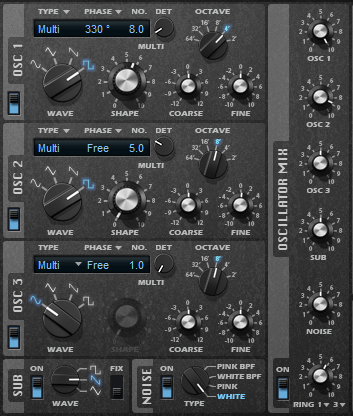Oscillator Section
The oscillator section offers six sound sources: three main oscillators, the sub oscillator, the ring modulation, and the noise generator. To create interesting electronic spectra, you can mix any of these sound sources.

For the three main oscillators, the following settings are available:
- On/Off
Activates/Deactivates the oscillator.
- Wave
Allows you to choose between the waveforms sine, triangle, saw, and square.
- Type
Single produces a single waveform.
If the square waveform is selected, the Shape parameter controls the pulse width, that is, the ratio between the high and low value of the square wave. A setting of 50 % produces a pure square wave. With settings below or above 50 %, the oscillator produces rectangular waves.
Sync provides different hard-sync oscillators, where each is a combination of a master and a slave oscillator. The waveform of the slave oscillator (sine, triangle, saw, or square) is reset with each full wave cycle of the master oscillator.
The Shape parameter adjusts the pitch of the slave oscillator, producing the typical sync sound.
Cross provides a combination of two oscillators where a master oscillator is modulating the pitch of a slave oscillator (sine, triangle, saw, or square) at audio rate.
The Shape parameter adjusts the pitch ratio between slave and master oscillator, resulting in a sound close to frequency modulation.
XOR (exclusive OR) compares two square waveforms with an XOR operation. Depending on the outcome of the XOR operation, the waveform of a third oscillator (sine, triangle, saw, or square) is reset.
The Shape parameter adjusts the pitch ratio of the square oscillators resulting in a sound close to ring modulation of the third oscillator.
Multi is a multi oscillator that can play up to eight oscillators simultaneously. You can specify the number of oscillators in the No. value field. This parameter can be set continuously. Values in between 2 integer values mean that an additional oscillator is mixed in at a reduced level.
If the square waveform is selected, the Shape parameter controls the pulse width, that is, the ratio between the high and low value of the square wave. A setting of 50 % produces a pure square wave. With settings below or above 50 %, the oscillator produces rectangular waves.
- Phase
Determines the initial phase of the oscillator when you play a note.
If this is set to Free Phase, the oscillator runs freely and continuously.
If this is set to Random Phase, the oscillator starts with a random phase.
If this is set to Fixed Phase, you can specify a fixed start phase (0-360°) for the oscillator.
- No.
If the oscillator type is set to Multi, this parameter determines the number of oscillators that play back simultaneously.
You can also set fractions of numbers. For example, with a setting of 2.5, you hear two oscillators at full level and a third oscillator at half level.
- Detune
If the oscillator type is set to Multi, this parameter specifies by how many cents the additional oscillators are detuned.
For example, if you use 5 oscillators and set Detune to 4, you get one oscillator at the original pitch, and 4 detuned oscillators at -8, -4, +4, and +8.
- Octave
Adjusts the pitch in octave steps.
- Coarse
Adjusts the pitch in semitone steps.
- Fine
Fine-tunes the pitch in cent steps.
Sub Oscillator
- On/Off
Activates/Deactivates the sub oscillator.
- Wave
Allows you to choose between three waveforms for the sub oscillator: triangle, saw, or square. The pitch of the sub oscillator is always one octave below the overall pitch. If you modulate the overall pitch, the sub oscillator follows.
- Fix
If this option is activated, the sub oscillator starts with a phase of 0 each time that a note is played.
If this option is deactivated, the oscillator runs freely.
Noise Generator
- On/Off
Activates/Deactivates the noise generator.
The Noise parameter is used for non-pitched sounds. In addition to standard white and pink noise, there are also band-pass filtered versions (BPF) of white and pink noise.
Ring Modulator
- On/Off
Activates/Deactivates the ring modulator.
- Ring Modulation Source 1/2
Ring modulation is produced by multiplying the signals of two oscillators. On these pop-up menus, you can select the sources for the ring modulation.
NoteFor the ring modulation to have an effect, the corresponding oscillators must be active.
Oscillator Mix
In the Oscillator Mix section, you can adjust the levels of the different oscillators, the noise generator, and the ring modulation.
Using Audio Input from your Steinberg DAW
If Side-Chain is activated in the Steinberg DAW, you can send the signals from your tracks to Retrologue.

If signals are sent to Retrologue via side-chain, the Input control becomes available in the Oscillator Mix section, allowing you to adjust the level of the signals that are coming in from the tracks in the DAW.
